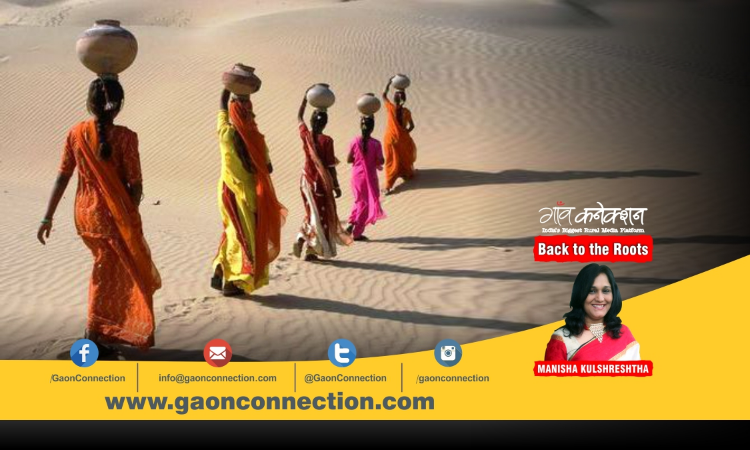Learn the art of saving water from those who live without it – the people of the desert
It takes doing without something to really make one appreciate it. The people of the desert who live without water know its value. Manisha Kulshreshtha tells us that we can learn the art of water conservation from them.
 गाँव कनेक्शन 28 Oct 2018 2:15 PM GMT
गाँव कनेक्शन 28 Oct 2018 2:15 PM GMT

Remember I had told you earlier that my Gaon Connection is very old. I was born in the desert – in Jodhpur. I spent my childhood in the villages there. And that I where most of my stories are born – in Rajasthan.
Marusthal – desert – just the word conjures up images of a vast expanse of sand – immense oceans of sand, dunes of sand that touch the sky, sand so hot it burns you, sandstorms that blind you. And in the midst of all this sand – long caravans of camels. Life here is an unending saga of scorching hot days – with temperatures soaring to 49 degrees Celsius – that are followed by bone-chilling cold nights.
Marusthal literally means land of death – where people, animals, plants can be driven to death by thirst. Such a scarcity of water that if people do not move away with their animals, they can die. India's desert is called the Thar Desert. This encompasses Rajasthan, Gujarat and parts of Punjab.
And when I was a little girl living there, in early 1970, we did not even have taps. The famous Gang Canal had not yet reached Rajasthan and without water, there were hardly any useful trees or plants. Cultivation of crops was not even a possibility. All that we had were some shrubs and cactus. The only colour we had, came from the yellow flowers of khejri – the state tree of Rajasthan. There was a severe water scarcity. Most of the wells had brackish water. One of two wells had sweet water. My mother was the headmistress of a government girl's school. People used to respect her a lot. And we had a lady who came to draw water from the well for us.
I was very little then. But if I spilled water, I would really get it. The area we were in was very dry, arid. If we left the water without a cover, it would become sandy. If food was left without covering, we would end up eating sand. But the saving grace was that the sand did not make our clothes dirty. So to conserve water, we would just wash the sweaty parts of our daily-wear clothes and school uniforms. Water was precious – we had to be very parsimonious in using it. Utensils were cleaned with dry ash – without a drop of water. We would just wipe them with a wet cloth before using them.
Kuchaman was a small hamlet where many Marwari families lived. I first picked up a pen and slate there. They had money, but water was still scarce. It was here that I first saw the traditional ways of rainwater harvesting. Many of the homes had a pucca water tank in the middle of their courtyards. All the rainwater would fall into this tank. Even the drains from the roof would bring the rainwater into the tanks. The families used this water for months after. This water was used for the family members as well as the animals. This water was the lifeline for the people in the trying times of drought. Having a source of water in the house was a blessing because otherwise, they would have to walk miles to get water from wells. This necessity ensured that they found inventive methods of preserving water. Even today, we can learn from the people of Rajasthan how to conserve water.
Like as I mentioned – getting utensils to shine with just dry ash. In some places, they sit on a cot and have a bath. The bath water is collected in a basin placed under the cot. This water is used to clean the house of for the animals.
Rainwater would also collect in ponds. As the heat would get more intense, this pond water would start to evaporate or slowly get soaked up by the parched earth. To conserve this water, they would make small wells – 25 to 30 ft deep. As the water from the pond would seep into the parched earth, it would get into the wells. SO even after the ponds would dry up, these wells would have water.
When digging wells, people would take into account the natural slant or slope of the land. This would ensure that when rainwater would seep into the ground, it would automatically collect downslope and come into the wells. This is important in deserts because the water table is very low and wells have to be dug really deep to get to the water.
Even after all these efforts, often many villagers would have to walk miles to get water. While mostly it fell upon the women to walk miles with pots of water on their heads, sometimes even beasts of burden like camels and donkeys were used for this.
Now drip irrigation has brought about a lot of changes. Drip irrigation is where the roots of plants get a controlled amount of water drop-by-drop through pipes. This saves water as it ensures that just the right amount of water reaches the plant – unlike when we water from a tubewell or through pipes in which case a lot of water is wasted.
Since I have seen how tough life can be without water, I know how precious it is. I cannot see water being wasted. Seeing water being wasted makes my blood boil. There is so much we can learn from the people living without water.
Manisha Kulshreshtha
More Stories




